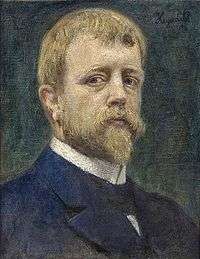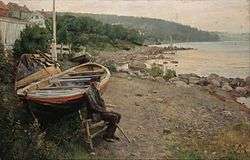Hans Heyerdahl

Hans Olaf Halvor Heyerdahl (8 July 1857, Smedjebacken, Sweden - 10 October 1913, Oslo) was a Norwegian Realist painter.
Biography
He was the son of Halvor Heyerdahl (1825–1900), a prominent engineer. In 1859, the family moved to Drammen, where his father took up the joint posts of City Engineer and Fire Chief. He began his education with the intent of following in his father's footsteps, but soon discovered that he was more attracted to drawing and art.[1]

In 1873, he entered the Norwegian National Academy of Craft and Art Industry and studied under Peder C. Thurmann, a landscape artist trained in Dusseldorf. The following year, he enrolled at the Academy of Fine Arts, Munich, where his professors were Wilhelm von Lindenschmit the Younger and Ludwig von Löfftz, who encouraged him to switch from landscapes to historical painting and portraits.[1][2]
From 1878 to 1882, he lived in Paris and won a third-place Medal at the Exposition Universelle for his painting of Adam and Eve's expulsion from Paradise, finished in 1877 under the guidance of Wilhelm Lindenschmit (1829-95).[2] He made his début at the Salon in 1879 with a portrait of the composer Johan Svendsen. While in Paris, he came under the influence of Léon Bonnat and took up painting en plein-air. In 1881, his work "Det døende barn" (The Dying Child) won the "Grand Prix du Florence" at the Salon, which enabled him to spend two years studying in Italy.[1]
After finishing his studies, he returned to Norway and settled in Christiania (Oslo), where he gave private art lessons to support his studio. His summers were spent painting in Åsgårdstrand, where he inspired Edvard Munch, who was just beginning his career. In addition to his landscapes, he did scenes from Norwegian history and several portraits of notable people, including Frits Thaulow (1885), Knut Hamsun (1893) and Henrik Ibsen (1894).
After 1900, he spent another six years in Paris, where his paintings took on a more melancholy tone. In 1904, he was named a Knight in the Order of St. Olav.[1]
Selected paintings
- Maria Magdalena (1882)
 Idyll (1906)
Idyll (1906)_The_Girl_with_Linen_Hair.jpg) The Girl with Linen Hair (c.1890)
The Girl with Linen Hair (c.1890) At the Window (1881)
At the Window (1881)
References
Further reading
- Hans Heyerdahl, 1857-1913, Exhibition catalog, Kunstnernes Hus (Oslo), 1957.
External links
| Wikimedia Commons has media related to Hans Heyerdahl. |
- ArtNet: More works by Heyerdahl
- Hans Heyerdahl website by Leif Osvold: Detailed biography and a complete list of his works.
- Hans Heyerdahl by Åsmund Thorkildsen @ the Drammen Museum of Art and Cultural History